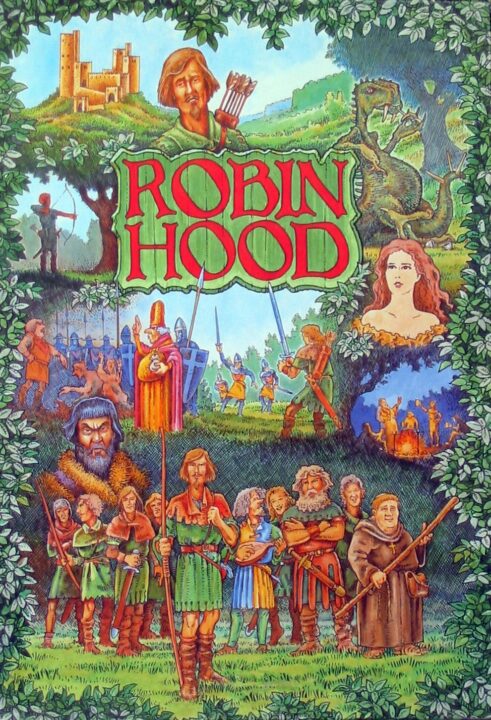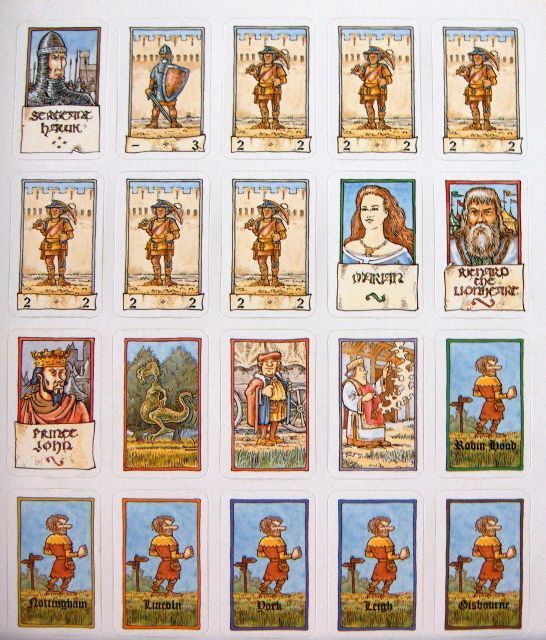Welcome to my review of the legendary tale that is now a board game—yes, Robin Hood! Grab your tights and feathered hats. I got together with my friends, formed a merry band (well, sort of), and set out to see if this adventure is worth your loot. Is it filled with brave heroics and clever teamwork? Did Friar Tuck eat all our snacks? And is this game fun, or does it belong in the sheriff’s dungeon? Let’s find out!
How It Plays
Setting up
Unfold the giant storybook board—yes, it feels like you’re about to read your niece a bedtime story, only now Uncle Jamie gets to be Robin Hood. Place the little wooden heroes on their starting spots. Shuffle the story cards and make a lovely little stack. Toss the coins and equipment tokens onto the marked spaces. Scatter the guards around like they’re looking for happy hour, and, voila, the forest is ready.
Gameplay
Each turn, you and your merry crew get to move around the board, solve story events, and rescue poor villagers. You don’t roll dice—you use these plastic ruler things to measure how far you can move. It’s clever and feels like sneaking around. You’ll flip tiles to search for stuff, avoid guards, and face moral choices. The story card system keeps surprises coming, like the time someone tripped an alarm and we all ran around like headless chickens.
Winning the game
To win, you all work as a team to complete missions before the guards make things too hot. Finish the chapter objectives (like freeing prisoners or stealing gold), and you get a victory. If you take too long or let the bad guys win, it’s game over for Sherwood. No one runs off with the loot alone—everyone wins or loses together. Just like a real band of outlaws, or my family trying to agree on pizza toppings.
Want to know more? Read our extensive strategy guide for Robin Hood.
Storytelling and Theme Immersion: Stealing the Show with Robin Hood
I’m not saying I wanted to be Robin Hood as a kid, but after playing the ‘Robin Hood’ board game, I did briefly try to tie a green bedsheet around my shoulders and ask my friends to call me Jamie of Locksley. That’s how good the theme sticks. The game plunges you straight into the leafy green heart of Sherwood Forest, and trust me, it never lets you out.
The story is everywhere. Each time you lift a piece on the board, something new happens—sometimes good, sometimes bad, sometimes it’s just another guard who looks like he wants to ruin your day (thanks, guards). The flavor text doesn’t just fill space—it actually makes sense and helps with the story. I’ve played my share of games that throw in some story to sound cool, but ‘Robin Hood’ feels like an actual adventure. And the best part? You work together! No one is left moaning in the corner because they’re not ‘the chosen one’ of the story. And the book you use as the rulebook and story guide? It’s like choose-your-own-adventure, but with more arguing over choices and less risk of falling asleep.
My friend Mick kept reading the story in his best Sean Connery accent. (Robin Hood: Prince of Wales? Prince of Bad Impressions, more like.) But these daft moments actually helped us feel even more a part of the adventure. The art and the story bits dig deep into the Robin Hood theme. Even if you have zero clue who Friar Tuck is, you’ll know by the end!
Coming up next, I’ll be poking my pointy stick at the gameplay mechanics and if they’re as fair as Robin’s legendary archery skills—or as wonky as Little John on stilts.
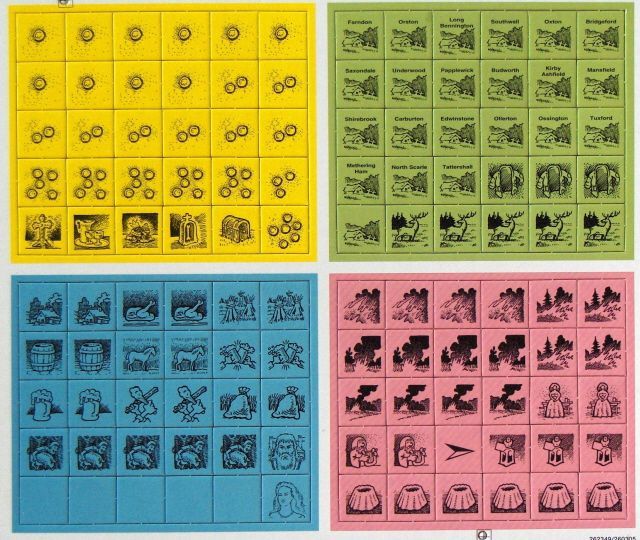
How Robin Hood Plays: Slicing Through the Gameplay and Balance
Let me put on my green hat and tell you about the beating heart of Robin Hood: its gameplay. Now, my friends and I played it over three Friday nights (one went late because someone – Andy – kept stealing the last slice of pizza instead of moving his meeple). The first thing you notice: there are no dice! Yes, really. Robin Hood says, ‘Luck, get outta here,’ and relies on tactical movement and story choices.
Each player moves their wooden hero pieces around a big, changing board, sneaking past guards, rescuing villagers, and collecting treasure. You measure your moves with little wooden rulers—seriously, I felt like a medieval architect. It adds a fun twist! Everyone acts as a team, which makes it less about winning individually and more about planning together. This works great if you like shouting at your friends, ‘No, go left, left!’
The balance is solid for the most part. The game scales well at different player counts, though it can get a little hectic with four. There’s the odd moment when one player gets all the excitement and another just stands around munching on snacks. But overall, most turns feel important. The rules avoid cheap tricks, so you won’t get booted out of Sherwood just because Andy unwrapped a lucky chocolate. If you hate games where luck decides the winner, Robin Hood keeps things fair and fun most of the time.
Next up, let’s see if the board and bits look as good as a freshly polished longbow. Stay tuned for my take on component quality and artwork!
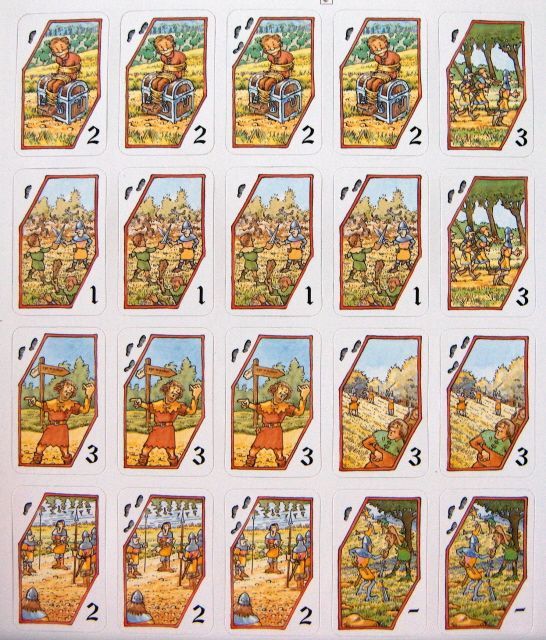
Piece by Piece: Robin Hood’s Top-Notch Components and Stunning Artwork
If you’re like me, you get weirdly excited opening a new board game box—it’s like Christmas, but with more cardboard. The Adventures of Robin Hood delivers a real treat for the eyes and hands. First, the board is massive and double-sided, with pop-out sections that you flip or swap as the story unfolds. It’s like the game board itself is part of a medieval escape room. My clumsy friend Dave popped out a tree and shouted, “I AM THE FOREST!” which startled the cat but made us all laugh. Moral of the story: handle the pieces with care or risk being pelted by a sprig of plastic shrubbery.
The wooden character meeples are chunky and easily distinguishable. There’s Robin Hood himself, Maid Marian, and the rest of the merry crew. They look great on the table, and it’s satisfying moving them around, almost like staging a little play. The included storybook is beautiful too, with thick pages and artwork that feels straight out of an illustrated fairytale. I did make the mistake of flipping ahead for spoilers—don’t do that unless you want to ruin a good plot twist!
The chits and tokens all punch out easily and don’t feel cheap. Nothing ruins a game faster than flimsy coins that bend like potato chips, and Robin Hood avoids that disaster. The bag for drawing tokens is sturdy, and after a bunch of frantic games with snacky hands, it’s still going strong. Even after a spilled soda incident, everything wiped clean—though the board now smells faintly of cola forever. If visual appeal and tactile joy tick your boxes, Robin Hood delivers big time in the component department.
Next, I’ll tell you all about how the game changes with different player counts and what keeps us coming back—snacks or no snacks!

Replayability and Fun with Different Player Counts in Robin Hood
One thing I always check before buying a game is how often I’ll want to pull it off the shelf. Let’s get real, some games fizzle out faster than my willpower during a diet. Robin Hood, though, has respectable replayability—especially if you mix up your player group.
With two players, Robin Hood feels a bit like a buddy movie. You get loads of time to plot and chat, but you might miss a bit of the chaos that comes with more people. At three or four players, the game shines. Suddenly you’re all arguing over who gets to sneak past the guard, or whose turn it is to distract the Sheriff. It can get lively and gives everyone a moment to shine, or occasionally to become the accidental villain by waking up half the sleeping patrol (looking at you, Dave).
The best bit is, the story changes based on your choices, and there are several scenarios to play through. That means you’ll actually want to play again, just to see if you can beat your last score or do better than last time’s comedy-of-errors. It’s no legacy game where you get new content forever, but Robin Hood has enough twists to keep you coming back for seconds… and maybe even thirds.
I 100% recommend Robin Hood if you want a game that handles replay well and doesn’t get stale, especially with the right group of friends. Unless you dislike fun, in which case, I cannot help you.
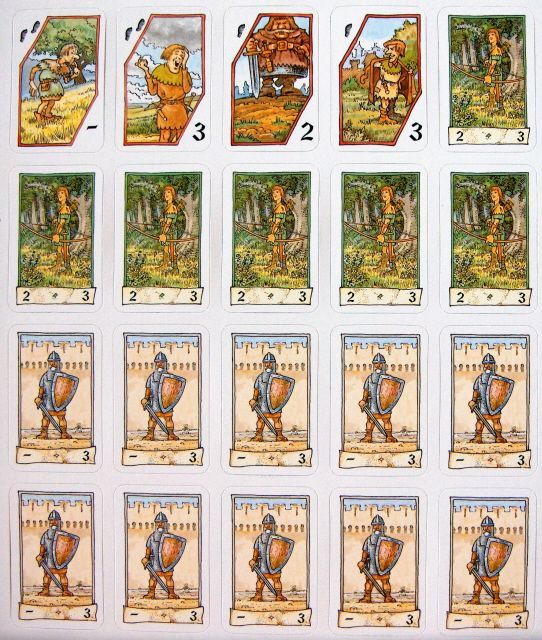
Conclusion
Alright, that wraps up my not-so-epic-yet-still-pretty-thorough review of the Robin Hood board game! After roping in my friends for countless adventures (and more than a few groans about my dodgy arrow skills), I can say this game is a strong pick if you love teamwork, story, and a touch of medieval flair. The artwork and chunky bits look great on the table. The rules feel fair and keep things moving, and I never felt cheated by pure dumb luck. There’s enough replay value to keep our group coming back, especially with 3 or 4 players. Sure, the little wooden rulers for movement made me feel like I was failing geometry class, but honestly, that’s part of this game’s charm. Robin Hood is a winner for co-op fans and anyone who likes a good tale with their game night. Just watch out for your band of merry pranksters trying to spend all the gold on snacks.

